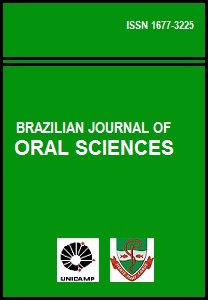Abstract
The aim of this study was to compare the cephalometric measures involving FMA (Frankfurt Mandibular Plane Angle), FMIA (Frankfurt Mandibular Incisor Angle), and occlusal plane angles (Frankfurt horizontal plane - occlusal plane) for cephalometric tracing by using anatomic and metallic porion points. Cephalometric tracing was performed in thirty head lateral teleradiographs divided into two groups. The anatomic porion point was marked in group 1, whereas metallic porion point was marked regarding the Frankfurt horizontal Plane (FHP). All measures were analysed. The mean values for FMA (32.33o ) and occlusal plane angles (10.77o ) in group 2 were statistically higher than those found in group 1 (FMA - 27.57o ); occlusal plane angle - 6.23o ). The mean value for FMIA angle (62.73o ) in group 1 was statistically higher when compared to group 2 (57,80°). According to these results, one can conclude that cephalometric tracing of porion points (either anatomic or metallic) alter the values for FMA, FMIA, and occlusal plane angles, thus resulting in different treatment plansReferences
Broadbent HB. A new x-ray technique and its application to orthodontia. Angle Orthod 1931; 4: 45-66.
Bjerin RA. A comparison between the Frankfort Horizontal and the sella turcica nasion as reference planes in cephalometric analysis. Acta Odontol Scand 1957; 15: 1-12.
Koski K. Some effects of the Growth of the cranial base and the upper face. Odont Tidski 1960; 68: 344-58.
Tng TT, Chan TC, Cooke MS, Hagg U. Effect of head posture on cephalometric sagittal angular measures: Am J Orthod 1993; 104: 337-41.
Nanda SK, Sassouni V. Planes of reference in roentgenographic cephalometry. Angle Orthod 1965; 35: 311-9.
Wei SHY The variability of roentgenographic cephalometric lines of reference. Angle Orthod 1968; 38: 74-8.
Wyllie WL. The assessment of anteroposterior dysplasia. Angle Orthod 1947; 17: 97-109.
Downs WB. Variations in facial relationship: their significance in treatment and prognosis. Am J Orthod 1948; 4: 812-40.
Tweed CH. The Frankfort-mandibular plane angle in orthodontic diagnosis, classification, treatment planning and prognosis. Am J Orthod Oral Surg 1946; 34: 175-230.
Tweed C. H. Evolutionary trends in orthodontics – past, present and future. Am J Orthod 1953; 39: 81-108.
Lima RS. Localização anatômica do forame auditivo externo em telerradiografias. Ortodontia 1981; 14: 97-100.
Vilela OV. Manual de cefalometria. Rio de Janeiro: Guanabara Koogan; 1998.
Vion PE. Anatomia cefalométrica. 2thed. São Paulo: Santos; 2002.
Pereira CB, Mundstock CA, Berthold TB. Introdução à cefalometria radiográfica. 2thed. São Paulo: Pancast; 1989.
Mitgard, J, Björk G, Linder-Aronson S. Reproducibility of cephalometric landmarks and errors of measurements of cephalometric cranial distances. Angle Orthod 1974; 44: 56-61.
The Brazilian Journal of Oral Sciences uses the Creative Commons license (CC), thus preserving the integrity of the articles in an open access environment.

